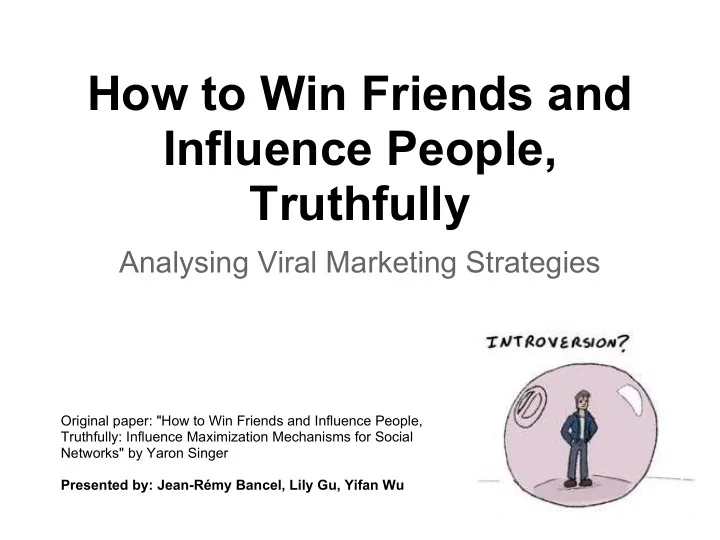

How to Win Friends and Influence People, Truthfully Analysing Viral Marketing Strategies Original paper: "How to Win Friends and Influence People, Truthfully: Influence Maximization Mechanisms for Social Networks" by Yaron Singer Presented by: Jean-Rémy Bancel, Lily Gu, Yifan Wu
Influence, Cont. Last week: ● Real data: Twitter/Facebook ● Empirical evaluation of influence Today: graphs, optimizations, greedy algorithms and mechanism design
Outline Problem Description & Motivation Past Research Singer's Mechanism Design Experiments & Results
Problem Description To promote a product with limited budget, who to target/convert? Problems to solve: ● Elicit cost to convert a customer ● How "conversion" propagates through the network. ● Optimize the influence given the budget
This is a very open question that has (too) many moving part
Knowledge of the Network? ● Could you get it? ○ Who's the principle? Ad platform or product companies ● Accurate representation? ○ Types of graph ■ Yelp, Amazon vs Facebook G+ ○ vs Physical network? ■ does it matter? ● Dealing with the size ○ Related to cost as well
Revealing cost ● Could you ask? ○ Are they truthful? ○ If not, how to reveal by implicit choices? ● Why not use the take-it-or-leave-it approach (posted price)? ● What is the cost anyways? ○ Time? Reputation?
Activation ● One time chance? ● Always positive? ○ No modeling for negative effects, is it linear etc.? ● What does this influence even mean? ○ Ads vs word of mouth ■ Why should your friend post an ad without compensation? ■ Is it money or opinion?
Clarifying the Research Goals Truthful Budget Feasible Computationally Efficient Bounded Approximation
Social Network A social network is given by:
Past Research - Diffusion Models ● Choosing influential sets of individuals - optimal solution is NP-hard. ● Submodular Model ○ Linear Threshold ○ Independent Cascade ● Game Theory Model
Submodularity We consider a set X with |X|=n. A set function on X is a function .
Game Theory Model For each player i in the network, we define: ○ action: A or B ○ utility function:
Coverage Model Model Coverage Function
Coverage Model
Coverage Model ● Too simplistic? No propagation ● Why using it? The coverage function is submodular
Goal ● Design an incentive compatible mechanism ○ incentive compatible = truthful ○ mechanism = algorithm + payment rule ● Input ○ Graph / Social network structure ○ Reported costs ○ Influence function ○ Budget ● Output ○ Subset of agents ○ Payment vector
Incentive Compatible Mechanisms ● Result: ○ Monotone ○ Threshold payments ● Myerson's Characterisation, 1981 ○ seller's optimal auction ○ direct revelation mechanism ○ preference uncertainty and quality uncertainty ○ monotone hazard rate assumption ○ virtual surplus
Monotonicity and Threshold Payments
Design Schedule 1. Design an approximation mechanism 2. Show performance guarantee 3. Show monotonicity
Mechanism Design
Weighted Marginal Contribution Sorting
Proportional Share Rule
Example - B=10 4 0.7 2 1 2 3 3.1 5 S C f 0 1 2 6 7 5 4 1,4 2.7 7 7 6 4 6 9 3 8 2 Optimal?
Performance Guarantee
Breaking Monotonicity .6 9 4 .91
Performance Guarantee
Fixing Monotonicity
Algorithm Monotone?
Details of the Condition
Algorithm
Summary What about payments?
Extending to Voter Model Random Walk ○ e.g. PageRank Reduce to the coverage model ○ Calculated the number of nodes to be influenced with the transition matrix
MTurk Experiment, Setup ● Advertise for a travel agency ● Ad method: posting a message with commercial content in their Facebook page ● Need to specify $$$ and # of friends on FB ● Reward ○ Each worker who participated in the competition was paid ○ the workers who won the competition received a bonus reward at least as high as their bid.
No Correlation! i.e.: OK to plug in to random node
Facebook graph ● Partial ○ degree distribution (as opposed to real degree) ● Steps ○ Limited to 5 (10% IC), 10 (1% IC), and 25 (LT) ● Uniform pricing ○ Here it chooses the best uniform price by an near- optimal approximation (a stronger assumption)
Related/Future Research Application: ● Does it (really) work? ● How long is each cycle ● Need data and ground truth Theory: ● Is efficient auction the most optimal? ○ Bulow-Klemperer's research ● The models? Negative reviews? ○ We've taken them for granted for this paper
Thanks & Questions Fun Fact Singer (the author) will be joining Harvard as an Assistant Professor of Computer Science in Fall 2013.
Recommend
More recommend